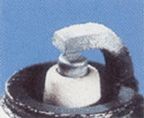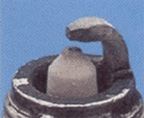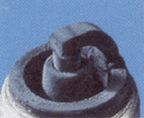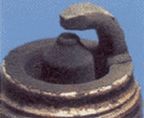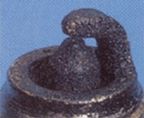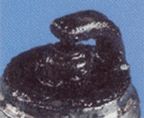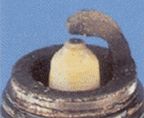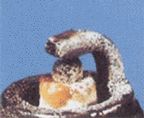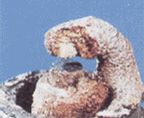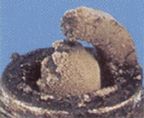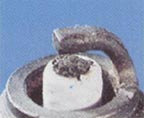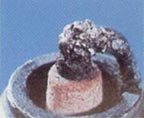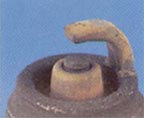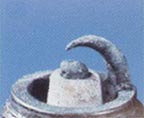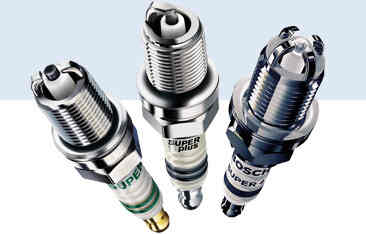
As the spark plug is vital to your engines running and performance, it's advisable to occasionally check their condition. Not only can you discover wear and tear of your spark plug, but with these easy to follow pictures, you can also learn a lot about the state of the engine itself.
Before you check your spark plugs, we do recommend the following to help make an accurate diagnosis: Drive your vehicle for a distance of preferably over 10 miles. While doing so, make sure you vary the rev's in the mid performance range and avoid extended idling before turning the engine off.
Normal
|
|
Insulator nose from grey-white / grey-yellow to russet color. Engine in order, heat range correctly selected. Mixture and ignition adjustment perfect, no misfires, cold start equipment functional. No residues of leaded fuel additives or alloy constituents from engine oil. No thermal overload. |
|
Sooted
|
|
Insulator nose, electrodes and spark plug housing covered in velvety matt black soot. Cause: Faulty mixture adjustment (carburetor injection), mixture too rich, air filter badly contaminated, automatic starter not in order or choke out too long, predominantly short trips, spark plug too cold, heat range code number too long. Effect: Misfires, poor cold start characteristics. Remedy: Adjust the mixture and starter correctly, check air filter. |
|
Oil Contamination
|
|
Insulator nose, electrodes and spark plug housing covered in oily soot or oil carbon. Cause: Too much oil in the combustion chamber. Oil level too high, badly worn piston rings, cylinders and valve bushings. In two-stroke spark-ignition engines, too much oil in the mixture. Effect: Misfires, poor cold start characteristics. Remedy: Overhaul engine, correct oil-fuel mixture, new spark plugs. |
|
Lead Fouling
|
|
Insulator nose exhibits brownish-yellow to green glaze in places. Cause: Leaded fuel additives. The glaze is formed under high engine loads following longer-term part load running. Effect: At higher loads, the deposit becomes electrically conductive and causes misfires. Remedy: New spark plugs, cleaning is pointless. |
|
Strong Lead Fouling
|
|
Insulator nose exhibits brownish-yellow to green glaze in places. Cause: Leaded fuel additives. The glaze is formed under high engine loads following longer-term part load running. Effect: At higher loads, the deposit becomes electrically conductive and causes misfires. Remedy: New spark plugs, cleaning is pointless. |
|
Ash Formation
|
|
Strong ash deposit of oil and fuel additives on the insulator nose, in the breathing space (annular orifice) and on the ground electrode. Loose, ash-like structure. Cause: Alloy constituents, especially of oil, can deposit this ash in the combustion chamber and on the spark plug face. Effect: Can result in auto-ignitions with loss of power and engine damage. Remedy: Put engine in order. Use new spark plugs and possibly a different oil. |
|
Melted-On Centre Electrode
|
|
Centre electrode melted on. Ground electrode also badly affected. Cause: Thermal overload due to auto-ignitions, e.g. resulting from ignition being set too early. Combustion residues in the combustion, defective valves, damaged distributor and deficient fuel quality. Heat range possibly too low. Effect: Misfires, power loss (engine damage). Remedy: Check engine ignition and mixture formation. New spark plugs. |
Melted-On Centre Electrode
|
|
Centre electrode melted on, blistered, spongy, softened insulator nose point. Cause: Thermal overload due to auto-ignitions, e.g. resulting from ignition being set too early. Combustion residues in the combustion, defective valves, damaged distributor and deficient fuel quality. Heat range possibly too low. Effect: Misfires, power loss (engine damage). Remedy: Check engine ignition and mixture formation. New spark plugs. |
Melted-On Centre Electrode
|
|
Caulifower-like appearance of the electrodes. Possible deposit of foreign material. Cause: Thermal overload due to auto-ignitions, e.g. resulting from ignition being set too early. Combustion residues in the combustion, defective valves, damaged distributor and deficient fuel quality. Heat range possibly too low. Effect: Misfires, power loss (engine damage). Remedy: Check engine ignition and mixture formation. New spark plugs. |
Heavy Wear on Centre Electrode
|
|
Cause: Spark plug replacement interval has been missed. Effect: Misfires, especially during acceleration (ignition voltage no longer sufficient for large electrode gap). Remedy: New spark plugs. |
Heavy Wear on Ground Electrode
|
|
Cause: Massive fuel and oil additives. Unfavourable flow influences in the combustion chamber, possibly as a result of deposits. Engine knocking. No thermal overload. Effect: Misfires, especially during acceleration (ignition voltage no longer sufficient for large electrode gap). Poor starting characteristics. Remedy: New spark plugs. |
